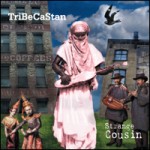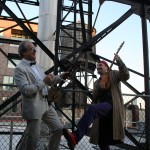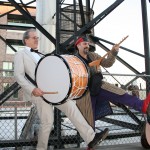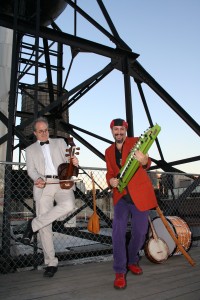Interview by Jim Hoey – Photos by Marilyn Cvitanic ——————————This interview was conducted at TriBeCaStan’s West Side studio, with helicopters rising and falling along the riverside, and the three of us, John Kruth, Jeff Greene, and myself, surrounded by the instruments of their trade, culled from a lifetime of travel and exploration. Fresh from a sold-out CD release party at Joe’s Pub for their latest offering, 5 Star Cave, the two offered insight into how they go about re-imagining folk music from around the Middle East, Northern  Africa, and other parts of the world. Based out of the crossroads of NYC, they have the advantage of hearing some of the traditional music they are inspired by pumping from cabs and bodegas, yet their embrace of the strange and foreign in music goes above and beyond mere curiosity or dabbling, and passes into the realm of living scholarship. Indeed, both have gone to the countries whose music they cherish, and have played with the masters, so they’ve got the authenticity down, and when you hear them grooving along with their top-notch Folklorkestra, you don’t doubt that what you’re hearing is the real thing.
Africa, and other parts of the world. Based out of the crossroads of NYC, they have the advantage of hearing some of the traditional music they are inspired by pumping from cabs and bodegas, yet their embrace of the strange and foreign in music goes above and beyond mere curiosity or dabbling, and passes into the realm of living scholarship. Indeed, both have gone to the countries whose music they cherish, and have played with the masters, so they’ve got the authenticity down, and when you hear them grooving along with their top-notch Folklorkestra, you don’t doubt that what you’re hearing is the real thing.
Jim Hoey: Can we start with a little background info, what are the beginnings of TriBeCaStan?
Jeff: Every Labor Day I have a jug band jamboree at my house, washboard bass, jugs, musicians, non-musicians all come together to get into the essence of the music. John came and I knew him, but I’d never met him before, I had a cassette of his from the late 80’s called Banshee Mandolin. He did crazy things with mandolin on that, and I liked bluegrass music, but what he was doing was bizarre, rock and rhythms.
John: I had a version of “Over Under Sideways Down,” by the Yardbirds, and that was the same time that I was touring with the band the Violent Femmes, and we were out on tour once with the Pogues, and I had a similar aesthetic about world music and folk, that was the same thing that Dylan had, he played it with a rock attitude, and I always came to folk music with a rock and roll attitude because I found that a lot of folk musicians were boring, but it doesn’t matter to me if it’s electric or acoustic, it matters the approach or attitude. And so I was playing mandolin, I was sick of 2 guitars, bass and drums, and later put together a really good rhythm section bass and drums with a mandolin. Why the hell not? I could play rockabilly, I could play gypsy, I could play whatever on it. Jeff was hip to that, he knew that I was doing that. So we were over at this party and some of the guys were playing Grateful Dead or Bob Dylan songs and I was like, you know just give me the revolver so I could either shoot them or shoot myself. Eventually it got much more interesting.
Jeff: Later it got more interesting, late at night, there was a hurdy gurdy player and this overtone singer, it just led into other things, but much later.
John: But it’s just like we do it at our shows, it depends on how you approach it, you have to drop the form, once you drop the form you are free of all the connotation and all the pre-packaged ways that people approach that music, you know it wasn’t John Lee Hooker or Lightnin’ Hopkins that put it in that form, it was the white guys in the late 50’s and 60’s that started to standardize it, and once you standardize it, it’s got no balls. It’s just the way you approach it.
Where is Tribecastan? from Cultural Animal on Vimeo.
JH: So from that night how did it come together?
Jeff: Well, it was fun and we got together and played a bunch of times together, basically played each other into the ground.
John: I think the thing that was interesting that happened with TriBeCaStan was that the first album, Strange Cousin, got some really nice reviews, and it must have rubbed some people the right way, the creativity and experimentation, it must  have, as Dylan said, “…disturbed people in the right direction,” and it seemed to me that a number of people said this is colorful and exotic and fun, “Maybe, if you could dance to it….” So, I come from a folk and a rock background so I thought, let’s take these colors, these melodies, the kind of thing we did on the first album and put a beat on it. The thing about Todd Isler [drummer], I heard him in a fusion band the first time, really fusion with lead guitar you know, it wasn’t really my cup of borscht. But I could tell he was good, but I kept hearing that he was a hand percussionist, and we were looking at first to get him to do that on the album. I wanted to get Idris Muhammad to do the regular drumming, because you know, he’s a god, he’s played on all these jazz records and he’s a funk monster, but I couldn’t seem to nail him down, and when we brought Todd over he was playing the sample machine, and then he said let me take a shot at the kit. We said, well, we’re going to get Idris Muhammad, and what’s he going to say to that you know? So he sat down and I was like Idris Muhammad who? Todd was there, he’s got so much soul, you know, he’s not playing with Mike Gordon [of Phish] for nothing, and he’s a great cat.
have, as Dylan said, “…disturbed people in the right direction,” and it seemed to me that a number of people said this is colorful and exotic and fun, “Maybe, if you could dance to it….” So, I come from a folk and a rock background so I thought, let’s take these colors, these melodies, the kind of thing we did on the first album and put a beat on it. The thing about Todd Isler [drummer], I heard him in a fusion band the first time, really fusion with lead guitar you know, it wasn’t really my cup of borscht. But I could tell he was good, but I kept hearing that he was a hand percussionist, and we were looking at first to get him to do that on the album. I wanted to get Idris Muhammad to do the regular drumming, because you know, he’s a god, he’s played on all these jazz records and he’s a funk monster, but I couldn’t seem to nail him down, and when we brought Todd over he was playing the sample machine, and then he said let me take a shot at the kit. We said, well, we’re going to get Idris Muhammad, and what’s he going to say to that you know? So he sat down and I was like Idris Muhammad who? Todd was there, he’s got so much soul, you know, he’s not playing with Mike Gordon [of Phish] for nothing, and he’s a great cat.
JH: So the first album seemed to be pulling from a more folk side of the traditions, but the new one seems to much more travelled…..
John: As Dr. Lateef, Yusef Lateef told me something that really made a lot of sense to me, he said, “We need to define things, the discursive mind is part of what we do, and how we define our lives every single day”. But honestly, are the Sex Pistols not folk music? That’s the most straight ahead folk music I’ve ever heard, other than “If I Had a Hammer,” are you going to tell me that an electric guitar is not a folk instrument? So what defines these things, is where we get into trouble the most. I’m playing a lot of banjo, right, and people ask me, “Do you play bluegrass, do you play old-timey?”, and I’m like, “I’m into trying to learn Arabic tunes, and Afghani music, and I’m working on something by Mingus, you know?” I think about that, what would Charlie Mingus think of having a banjo on one of his songs?
Jeff: Maybe he’d choke the guy or love it.
John: I don’t know maybe I fell off my bike when I was a kid and hit my head the right way. The reason I bring up Yusef is that he just called it segregation, music should just be alphabetized, and the hell with these terms, it’s interesting where these new terms develop. It’s funny, a guy who was writing a magazine up in Connecticut was trying to come up for a new term for the music happening at CBGB and around town and what TV show was big at the time? Kojak. And on that show Telly Savalas used to grab the guy by the neck and say, “Listen you no good punk….” This guy saw that show, and thought, that’s it, that’s what these guys are, a bunch of punks. That was Legs McNeil, and he just called his magazine Punk. So, yeah, the band now, we’re referring to it as a “folklorkistra”, I think I had that idea when I was 18, when I thought that there should be a sitar in a symphony orchestra. There’s something great about taking things out of context and using it differently. And there’s no segregation in TriBeCaStan. There is no hierarchy of sound. It has to do with finding a song on an instrument because it loans itself to the song, or suggests something.
JH: So you could have gamelan on the next album for example?
Jeff: I’ve been fascinated by the rhythm of gamelan for years, just the way of thinking and structuring the rhythm in larger and smaller parts.
JH: The instrumentation is very important for the music you make, as eclectic as it is. Can you reflect on the instruments in your “arsenal,” if you will, and how you acquired them?
Jeff: The choice of instruments is made mostly based on timbre and sound. Trying to find just the right color from this gigantic coloring box to add to or complement a mix. But part of it also has to do with how different instruments inform and influence their players. Some instruments suggest melodies or ways of playing that flow from the culture or people who produced the instruments and some instruments beg to be played in ways that their makers never intended. The Trinidadian steel pan sounding like the metallophones of the Javanese gamelan for instance. So although we respect traditions we do not try to emulate classical or traditional uses of the instruments, but rather to use them as inspiration and creative tools to express and articulate whatever our musical ideas require. I have well over 200 instruments from all over and I confess I am a sufferer of IAS, “instrument acquisition syndrome.” Most instruments I find in my travels, also friends tend to bring me instruments as presents from all around the world, and lastly if I see or hear an instrument whose sound captivates me I often become obsessed in finding one so that I can understand how that sound was produced. All my instruments get played! They are not wall hangers and recently when I moved to a smaller loft I sold off and gave away many instruments because they weren’t being played. Of course it’s like having children or pets that require attention and although I can’t play them all, all the time, like good old friends they bring me great pleasure when I do sit down and discover something new with them. Also, certain scales come out of certain instruments, and are suggested by the physical form of the instruments as well and certain tonalities come out of certain cultures. Are people dancing to it or is it being played at the court, you know?
JH: How did you feel about the CD release show at Joe’s Pub?
John: It was great, we just wanted to play another hour, you know. Also, what’s interesting about this album, I see it as a journey, as a cathartic musical journey, that starts at one spot and brings you to another, and then leaves you hanging at the end, with this weird impressionistic thing. I don’t know, if we had more time and people were actually listening straight through, because people are no longer listening from the beginning to the end along the path that the artist has laid out, that was such a beautiful thing, and it’s getting lost, or is already long lost. [Ed.-with digital recordings, downloads, etc.]
Jeff: I think the CD release party was great fun, wonderful energy both onstage and from the audience and several of the musicians mentioned they could “feel the love” as someone put it. We clearly have a great time playing with each other and hopefully this comes across. There are some fantastic players and even though not all of them were on the disc, many of them have played together for a long time. Dave Dreiwitz, the bass player, has been playing with John for decades and is on our first record. The only reason he wasn’t on the second is because he was busy touring with Ween at the time. Todd Isler is a monster drummer and really knows a lot about world rhythm and exotic hand percussion having studied in Africa and India and he wrote a book about Indian SolKattu. We finally let down the prohibition about no guitars in TriBeCaStan after Scott Metzger came to one of our rehearsals and just fit right in with his eccentric non-guitar sensibilities which seem to mesh perfectly with our own out-there attitudes. Ibrahim Gonzalez is a kindred spirit and adds his enthusiastic energy and Latin spice to the mix with great percussion. The horn section of John Turner and Claire Daly is a terrific addition to our sound. John calls himself a street musician although he is formally trained and plenty accomplished. He brings this wild intensity and unique phrasing, again treating his instrument as if it were something new rather than just a trumpet. Claire is a virtual veteran jazz musician who has played with many folks including James Brown and Taj Mahal. Her musicianship is impeccable while the rest of us are wild beasts. We love her solos and the sounds she gets out of her Bari (baritone sax). Kenny Margolis has also been playing out there for decades and John and he have played together on various projects. He brings a Cajun, roots, rock accent to the gumbo and fits right in on accordion and keys.
JH: What’s next for TriBeCaStan?
Jeff: Well, John has plans to be in Croatia for a while and I have quite a bit of traveling to do this summer (I just returned from a musical odyssey to Azerbaijan and Georgia) but we are playing a Kirtan (a call-and-response chanting performance in India’s devotional traditions) tomorrow and we have been invited to the International Jews Harp Festival in Hungary this September. We have another 20-30 unrecorded tunes we have written and worked on and there was an idea about recording a more urban TriBeCaStan Noir CD, so we will have to see which we get to first. Certainly more playing out in the city whenever we can.
Read more about this band in DBDBD
Up coming show: Sunday, September 5th, 2010 at COCO 66 (6 Greenpoint Ave, Brooklyn, NY 11222, 718-389-7392)






